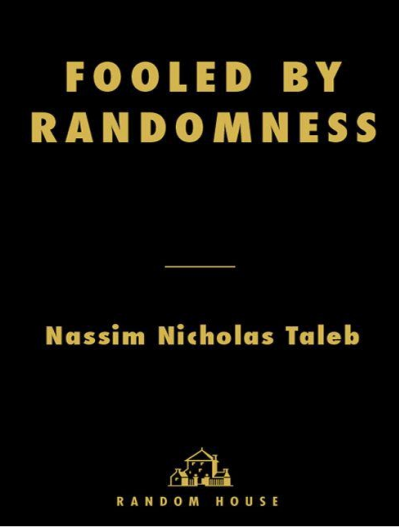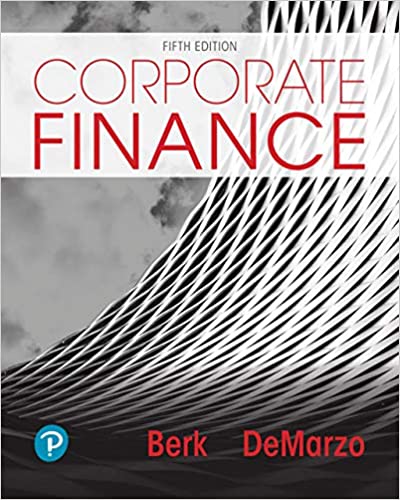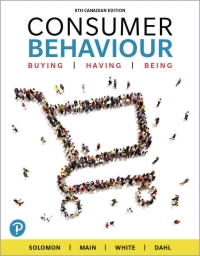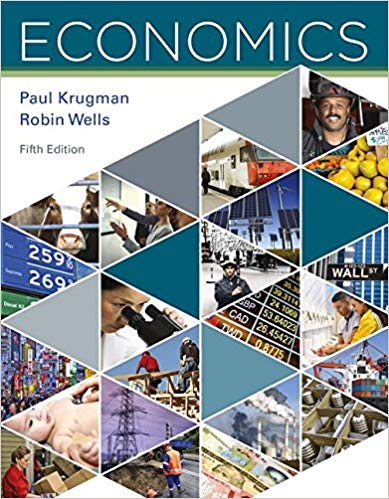موضوعات
آموزش و پرورش
ادبیات و زبان
پزشکی، دندانپزشکی و داروسازی
تاریخ و جغرافیا
داستان و رمان
دیگر
دین و فلسفه
روانشناسی
ریاضیات و آمار
سلامتی، تناسب اندام و رژیم غذایی
شیمی و پلیمر
علوم اجتماعی و حقوق
علوم زیستی و بیوتکنولوژی
فیزیک و نجوم
کامپیوتر و اینترنت
کتابهای کودکان و داستان
کسب و کار و اقتصاد
کشاورزی و دامپزشکی و غذا
معماری
مهندسی و فناوری
هنر و تئاتر
محصولات
Fooled By Randomness - PDF
نویسندگان: خلاصه: This is my book summary of Fooled by Randomness by Nassim Nicholas Taleb. My notes are informal and often contain quotes from the book as well as my own thoughts. This summary also includes key lessons and important passages from the book. According to Taleb, the book's most popular chapter was Chapter 11, the one in which he compressed all the literature on the topic of miscalculating probability. Important point: “it's more random than we think, not it is all random.” Chance favors preparedness, but it is not caused by preparedness (same for hard work, skills, etc.) “This business of journalism is just about entertainment, particularly when it comes to radio and television.” As much as we want to “keep it simple, stupid” … It is precisely the simplification of issues that are actually very complex, which can be dangerous. “Things that happen with little help from luck are more resistant to randomness.” “Mild success can be explainable by skills and labor. Wild success is attributable to variance.” One common theory for why people pursue leadership is because of “social emotions” which cause others to be influenced by a person due to small, almost imperceptible physical signals like charisma, gestures, and gait. This has also been shown via evolutionary psychology: when you perform well in life, you get all “puffed up” in the way you carry yourself, the bounce in your step, etc. From an evolution standpoint this is great because it becomes easier to spot the most successful / desirable mate. The concept of alternative histories is particularly interesting. If you were to relive a set of events 1000 times, what would the range of outcomes be? If there is very little variance in your alternative histories (i.e. You chose to become a dentist and you will probably make more or less the same amount of money and live a similar lifestyle all 1000 times), then you are in a relatively non- random situation. Meanwhile, if there is a very wide range of normal results when considering 1,000 variations (entrepreneurs, traders, etc.), then it is a very random situation. The quality of a choice cannot be judged just by the result. (I first learned this in baseball. Just because a pitch you call or play you call doesn't work out doesn't make it a poor choice. It could have been the right call, but bad luck. Or vice versa.) “Certainty is something that is likely to take place across the highest number of different alternative histories. Uncertainty concerns events that should take place in the lowest number of them.” You should think carefully about getting more insurance / shielding yourself from events that — although unlikely — could be catastrophic. You essentially want to insulate yourself from terrible random accidents. We have a tendency to see risks against specific things as more likely than general risks (dying in a terrorist attack while traveling vs. dying on your next trip, even though the second includes the first). We seem to overvalue the things that trigger an emotional response and undervalue the things that aren't as emotional. We are so mentally wired to overvalue the sensational stories that you can “realize informational gains by dispensing with the news.” Fascinating famous Swiss study of the amnesia patient who couldn't remember doctor's name but did remember him pricking her hand with a pin. “Every man believes that he is quite different.” It's better to value old, distilled thoughts than “new thinking” because for an idea to last so long it must be good. That is, old ideas have had to stand the test of time. New ideas have not. Some new ideas will end up lasting, but most will not. The ratio of undistilled information to distilled is rising. Let's call information that has never had to prove its truth more than once or twice, undistilled. And information that has been filtered through many years, counter arguments, and situations is distilled. You want more distilled information (concepts that stand the test of time and rigorous analysis) and less undistilled information (the news, reactionary opinions, and “cutting edge” research). There is nothing wrong with losing. The problem is losing more than you plan to lose. You need clear rules that limit your downside. (“If any investment loses one million dollars then our firm sells immediately.”) Much of what is randomness is timing. The best strategy for a given time period is often not the best strategy overall. In any given cycle, certain places will be dangerous, certain trading strategies will be fruitful, etc. If you find yourself doing something extraordinarily well in a random situation, then keep doing what's working but limit your downside. There is nothing wrong with benefitting from randomness so long as you protect yourself from negative random events. Randomness means there are some strategies that work well for any given cycle (an extreme fad diet), but these cycles are often short to medium term successes. More importantly, the strategies that work for a given cycle in the short term may not be the best for long run. They are sub optimal strategies winning over a randomly beneficial short term cycle. The same can said for setting huge goals, following a fad diet, chasing an extreme training protocol, and so on. Unsustainable and suboptimal for the long term. In this way, evolutionary traits that are undesirable can survive for a period of time in any given population. That is, suboptimal strategies and traits can seem desirable in the short run even though they will be resoundingly defeated in the long run. Important point: you can never affirm a statement, merely confirm its rejection. There is a big difference between “this has never happened” and “this will ever happen.” You can say the first, but never truly confirm the second. It just takes one counter example to prove all previous observations wrong. We never know things for sure, only with varying degrees of certainty. There are only two types of ideas. Those that have been proven wrong and those which have yet to be proved wrong. (Feynman said something similar.) Strive to become a man of leisure who can afford to sit with ideas, think properly about them, and gradually provide something of value. Science is speculation. This is important to remember. Scientists are simply creating well-formed and well-educated conjectures about the world. But they are still conjectures that can be proved incorrect by one random event. It's a difficult standard to demand that you can actually implement ideas and not merely share them (there have been many brilliant philosophers and scientists who have had great ideas they didn't personally use), but is an idea really that great if you can stick to it? Obviously, everyone has different skills and circumstances, so maybe someone can use your idea even if you can't. But generally speaking, I think you should be able to live out the ideas you share. Pascal: “the optimal strategy for humans is to believe in the existence of God. For, if God exists, then the believer will be rewarded. If God does not exist, the believer will have nothing to lose.” My first thought: “yes, but what if you believe in the ‘wrong' God?” Should you play a numbers game and believe in the God most people believe in? Or, can we safely assume that of the infinite number of possible Gods humans could have designed it is unlikely that any of the ones we worship are actually the God? So, just believe that a higher power exists? Whew. Tough call here. Social treadmill effect: you get rich, move to a better neighborhood, surround yourself with more successful people, and feel poor again. “Remember that nobody accepts randomness in his own success, only his failure.” Skewness and expectations: you can't just look at the odds of something happening, but also the payoff you receive if it works (and the cost of it failing). A bet on something very unlikely can be smart if the payoff is large and you have rules to limit the many small losses that are likely. Minor stalemates in life can often be solved by choosing randomly. In many cases it doesn't really matter so long as you choose something and move forward. We follow rules not because they are the best options, but because they make things fast and easy. Humans are inherently flawed. The cognitive biases that we have are simply a result of how our brains work. Sometimes these biases help us rather than hurt us. But they are always a result of how we are built. That makes them particularly difficult to avoid. We seem to focus too much on “local” changes, not global ones. That is, we care too much about the latest change rather than the overall trend. “Wealth does not make people happy, but positive increases in wealth may.” We do not think, but use heuristics to make decisions. Emotions are “lubricants of reason.” We actually need to feel things to make decisions. Emotions give us energy and they are actually critical to life in the day-to-day world. In other words, the goal here is not to become a robot who can analyze everything with perfect logic. Even if you know about randomness and cognitive biases, you are still just as likely to fall victim to them. How to overcome these biases? We need tricks. We are just animals and we need to re-structure our environment to control our emotions in a smart way. “Most of us know pretty much how we should behave. It is the execution that is the problem, not the absence of knowledge.” “I try to remind my group each week that we are all idiots and know nothing, but we have the good fortune of knowing it.” Do not blame others for your failures. Even if they are at fault. The only aspect of your life that fortune does not have control over is your behavior. Repetitiveness is key for determining if you are seeing skill or randomness at play. Can't repeat it? Not skillful. “We favor the visible, the embedded, the personal, the narrated, and the tangible. We scorn the abstract. Everything good — aesthetics, ethics — and wrong — fooled by randomness — with us seems to flow from it.”Made to Stick: Why Some Ideas Survive and Others Die - PDF
نویسندگان: خلاصه: This is a crash course on how to make your ideas understood and remembered by other people. Whether you want to write a book, sell a product, or become a better storyteller, you’ll learn a useful playbook for understanding what makes an idea good and how to cement it into the mind of others. Key Takeaways Making ideas stick To make ideas stick, you can leverage the SUCCESs framework: Simplicity – makes something understandable Unexpectedness – makes people pay attention Concreteness – makes people understand and remember Credibility – makes people agree and believe Emotional – Makes people care Story – Inspires people to act The book is organized around understanding each of these six pillars of making ideas stick. 1. Simplicity Find the core idea Sticky ideas must be simple. Simplicity means you have found the core of the idea. You have stripped an idea down to its critical essence. For example, Southwest Airlines prioritizes one mission above all else: “We are the low-fare airline.” The mission is clear and simple enough to guide employee decisions. Don’t bury the lead Start with the most important idea. Journalists are taught early on not to “bury the lead.” The same is true for conveying your core idea. Whether you’re giving a talk, writing copy for a landing page, or sharing a story, start with the lead. That means getting rid of the fluff and centralizing around the core idea. What’s a simple idea? “Short sentences (compact) drawn from long experience (core). We are right to be skeptical of sound bites, because lots of sound bites are empty or misleading—they’re compact without being core. But the Simple we’re chasing isn’t a sound bite, it’s a proverb: compact and core.” Say one thing instead of three “When you say three things, you say nothing. When your remote control has fifty buttons, you can’t change the channel anymore.” Even if you have four good points, it’s better to focus on the one that matters most. Cutting the fat sometimes means cutting good ideas. Use familiar concepts and schemas Describe something in terms of a concept that’s already familiar. For example, imagine you wanted to explain what a pomelo was to someone who didn’t know. “Explanation 1: A pomelo is the largest citrus fruit. The rind is very thick but soft and easy to peel away. The resulting fruit has a light yellow to coral pink flesh and can vary from juicy to slightly dry and from seductively spicy-sweet to tangy and tart.” “Explanation 2: A pomelo is basically a supersized grapefruit with a very thick and soft rind.” Explanation 2 wins because most people are familiar with a grapefruit, and that familiarity can allow them to more easily grasp what a pomelo is. Great teachers use schemas that people are familiar with: “Good teachers intuitively use lots of schemas. Economics teachers, for instance, start with compact, stripped-down examples that can be understood by students who have no preexisting economics schemas. “Let’s say that you grow apples and I grow oranges. We’re the only two people around. Let’s also say that we’d prefer to eat some of both fruits rather than all of either. Should we trade? If so, how do we go about doing it?” Avoid the curse of knowledge “Once we know something, we find it hard to imagine what it was like not to know it. Our knowledge has “cursed” us. And it becomes difficult for us to share our knowledge with others, because we can’t readily re-create our listeners’ state of mind.” You know you’re suffering from the curse of knowledge when you want to be accurate to the point where most people don’t understand. It’s better to break down things into simple terms so that more people can grasp what you’re saying than to get all of the precise details correct for someone who is not an expert. How to pitch It’s more effective to use things people are already familiar with. For example, you’re new company is the “Uber for x” or your new movie is “Jaws on a spaceship.” People can quickly grasp what it is you’re trying to do and not be bogged down by all the nuances of the project. 2. Unexpectedness A core challenge of communicating your ideas is getting people’s attention, especially if you’re not already famous or known as a highly credible source in a particular field. Unexpectedness can help. Break a pattern “The most basic way to get someone’s attention is this: Break a pattern. Humans adapt incredibly quickly to consistent patterns. Consistent sensory stimulation makes us tune out.” For example, think about how you feel when airlines begin reviewing safety information about life jackets, oxygen masks, and so on. You probably tune out because it’s boring and familiar. But if a safety instructor started making jokes and broke the script, that might actually get your attention. It’s unexpected, and all of a sudden you’re listening to something that you would have otherwise ignored. Power of surprise “So if emotions have biological purposes, then what is the biological purpose of surprise? Surprise jolts us to attention. Surprise is triggered when our schemas fail, and it prepares us to understand why the failure occurred.” Breaking a pattern can help get people’s attention by surprising them, but you also need to figure out how to keep their attention. For example, a clickbait headline may be useful in getting people to view your article, but it won’t ensure that people read the full piece. If they don’t read the piece, then what’s the point? You may increase your pageviews, but you don’t increase your influence. Power of mystery “Curiosity is the intellectual need to answer questions and close open patterns. Story plays to this universal desire by doing the opposite, posing questions and opening situations.” A mystery story draws people in. It incites curiosity and gets them wondering about the answer. Beginning with a mystery story can get the audience bought into the puzzle that you’d like to solve with them. People want to know: “What will happen next? How will it turn out?” That’s what keeps them invested in the story. You create a mystery by first opening gaps. Those gaps should make the audience want to know what happens next. A good mystery is only useful if the person reading about it wants to know what happens next. You can then close the gaps via the story. An important part of closing the gap is how you sequence information. A good story drops clues incrementally, keeping the reader hooked. 3. Concreteness Telling concrete stories that reveal deep truths is a more powerful way to share a message than listing out an abstracted truth. A good example is “The Fox and the Grapes” by Aesop. One hot summer day a Fox was strolling through an orchard. He saw a bunch of Grapes ripening high on a grape vine. “Just the thing to quench my thirst,” he said. Backing up a few paces, he took a run and jumped at the grapes, just missing. Turning around again, he ran faster and jumped again. Still a miss. Again and again he jumped, until at last he gave up out of exhaustion. Walking away with his nose in the air, he said: “I am sure they are sour.” It is easy to despise what you can’t get. We can all relate to and remember this story, and it has more meaning than if someone just said, “It is easy to despise what you can’t get.” The concrete details of the fable bring meaning to a common blunder of the human psyche. Abstraction “Abstraction is the luxury of the expert.” Experts often share ideas in complicated terms that only fellow experts can understand. They are plagued by the Curse of Knowledge and want to show how informed they are about a topic. But this type of abstraction is unhelpful to a novice. It clouds the message that is being shared to the point that it is never understood. Concrete language, including vivid and digestible details, can help bridge this gap. In part, that’s because concrete words are more memorable than abstracted ones. If I wanted to teach you about accounting, for example, I could talk about income statements, balance sheets, and accounts receivable. Or, I could ask you to help figure out if two students selling a product online have a feasible business idea. The specific example of students (who are like you) can help you put the abstracted concepts into practice in a way that can make them tangible and digestible. The result is that you learn about the core concepts of accounting without having to study a dictionary of confusing terms. 4. Credibility Credibility is an important part of making an idea stick, but how do you establish credibility? There are a few ways – statistics are one of them. Using statistics effectively “Statistics are rarely meaningful in and of themselves. Statistics will, and should, almost always be used to illustrate a relationship. It’s more important for people to remember the relationship than the number.” Let’s say you wanted to talk about the importance of employee dissatisfaction in your workforce. You could site a number of statistics: Only 25% of people say they have a clear understanding of their job Only 15% of people were enthusiastic about their job Only 30% of people say they have enough resources to execute key goals These statistics are helpful, but they are still very abstract. You might come away feeling that there is a lot of dissatisfaction at the company, but no idea of how serious this issue may be. A more useful way to describe what’s going on is to compare the numbers to something people have a grasp of. Drawing from an example in Steven Covey’s book, you could say something like: “If your workforce was a soccer team, only 4 out of 11 players would know which goal is theirs. Only 2 out of 11 would care. Only 2 of the 11 know what position they play and know exactly what they are supposed to do. And all but two players would, in some way, be competing against their own team members rather than the opponent.” By humanizing the statistics in this way, it’s easy to understand that something needs to be fixed. In fact, it would seem ridiculous if an organization didn’t figure out how to change things quickly. Another example is evaluating whether or not you should make an investment. You could say, “The cost of making this investment would be about $500 per employee annually.” In these terms, you need to figure out if the benefit of the investment is more than $500. One way that you can frame the “Is it worth it?” question is to say: “If you believe you can increase an employee’s productivity by one to two minutes a day, you’ve paid back the cost of the investment.” That makes the investment a no-brainer, versus an abstracted cost/benefit calculation does not. Sinatra Test One way to establish credibility is to leverage the Sinatra Test: If you can make it there, you can make it anywhere. This is particularly useful for small or unproven businesses. The idea is that you prove yourself with a big and important customer under difficult circumstances, and that action alone gives people confidence that you can do that for many more people. “We made sure that all Amazon deliveries arrived on time during Christmas” is a much more powerful signal to other potential customers than “98% of our deliveries arrive on time.” 5. Emotional “If I look at a mass, I will never act. If I look at the one, I will.” – Mother Teresa If I tell you that 5 million African children die of malaria every year, you will likely feel bad about the problem. But how motivated will you be to act? It’s hard to conceptualize 5 million people in suffering, and you may feel like whatever you do will be an unhelpful drop in the bucket. If, on the other hand, I tell you that Rhonda, a young girl in Africa may die from a preventable disease, and all you need to do is donate $50 annually to save her life, that’s a no-brainer. You’re going to be much more likely to donate to the cause and feel. like you’re doing something really meaningful. Charities have tapped into this quirk of human psychology by sharing the stories of individual people who are suffering from things that impact large numbers of people. The individual story taps into our emotions in ways that large and scary numbers don’t. Creating an emotional response inspires people to act. In the case of charities, sharing single detailed stories of specific individuals leads to more donations and impact. Semantic stretch When we overuse a term that generates an emotional response, it leads to a dampening of the emotional response. For example, let’s say we see artsy people that like to buck societal norms and call them “hipsters.” That word has meaning and gives us the feeling of what a hipster is and represents. But as the term gets adopted more widely, we start calling more and more things “hipster.” Suddenly, all modern designs or people wearing specific types of clothing are hipster. Or maybe even bucking a societal trend in and of itself is “hipster.” Over time, as the word expands to describe many more things than the original meaning, it loses its emotional resonance because it’s been overused. This concept is caused semantic stretch. Leveraging self-interest People care about themselves and what they want. So if you’re writing copy, it can be useful to put it in terms that highlight the ways in which an individual may benefit. Often, it’s helpful to give people a way to visualize the value of what you’re offering. The tangibility of your visualization, rather than the magnitude of the change you’re promising, can lead to the most action. Maslow’s Pyramid Tapping into people’s self-interest is useful, but people have a wide range of needs. Depending on what you’re offering, you may want to tap into the wider set of their needs. Maslow’s Pyramid is a good framework for understanding the full range of what people may care about: Transcendence: help others realize their potential Self-actualization: realize our own potential, self-fulfillment, peak experiences Aesthetic: symmetry, order, beauty, balance Learning: know, understand, mentally connect Esteem: achieve, be competent, gain approval, independence, status Belonging: love, family, friends, affection Security: protection, safety, stability Physical: hunger, thirst, bodily comfort To create an emotional response, you can convey value in terms of some of these needs. 6. Story Mental simulation If you ask someone to think about a certain future to simulate a problem they need to solve, they will often come up with a more vivid and accurate understanding of the situation. They will see things that they otherwise ignored in an abstracted planning process. For example, imagine you quit drinking, and you were worried about a party with friends coming up. Instead of arriving at the party sober and hoping that your self-control could win out, you could visualize the event. Visualize the subtle peer pressures you might face and what you could do in that situation. If you do that, you’re more likely to be prepared and comfortable with this potentially challenging social situation. Jared at Subway The story of Jared, the guy who lost hundreds of pounds eating Subway sandwiches, lead to massive growth for the Subway chain. It took a savvy and persistent group of people who first spotted and then believed in the story before the company decided to feature it, but it ended up being one of the most successful stories for fast-food sales growth than any other. Instead of “Subway has low-fat sandwiches,” people saw that “Jared, an everyday guy, lost a ton of weight by eating Subway every day.” That story had a lot more staying power than a description of the nutritional properties of the sandwiches. Common story plots You can leverage various types of common stories. Challenge Plot: Someone overcomes a formidable challenge and succeeds (e.g., David and Goliath). Connection Plot: People who develop a relationship that bridges a gap – racial, class, ethnic, religious, demographic, etc. (e.g., everyone drinks Coca Cola) Creativity Plot: Someone makes a mental breakthrough, solving a hard puzzle, or finding an innovative solution to a problem . Stories are particularly effective in dismantling the Curse of Knowledge. By sharing a simple and concrete story that people can relate to, you can move away from abstracted lessons and move toward a narrative that people can follow and take away something valuable.Consumer Behaviour Buying, Having, and Being (8th Canadian Edition) - HQ Pdf
نویسندگان: خلاصه: Consumer Behaviour Buying, Having, and Being, Eighth Canadian Edition, 8th Edition by Michael Solomon; Katherine White; Darren W. Dahl; Kelley Main and Publisher Pearson Canada. ISBN: 9780135403129, 013540312X. The print version of this textbook is ISBN: 9780135433942, 0135433940.آیا کتاب مورد نظر هنوز بر روی سایت قرار نگرفته است؟ جای نگرانی نیست! کافی است بر روی گزینه سفارش کتاب کلیک کرده و درخواست خود را ثبت کنید. در کمتر از چند ساعت کتاب شما را آماده خواهیم کرد.








![Trigonometry: A Unit Circle Approach (11th Edition) [2020] - Original PDF](https://dl.libsan.ir/images/1/12/Trigonometry_5eba3e85291b5.jpg)
